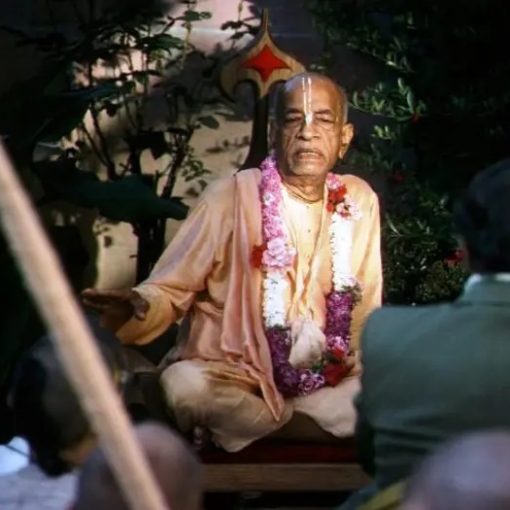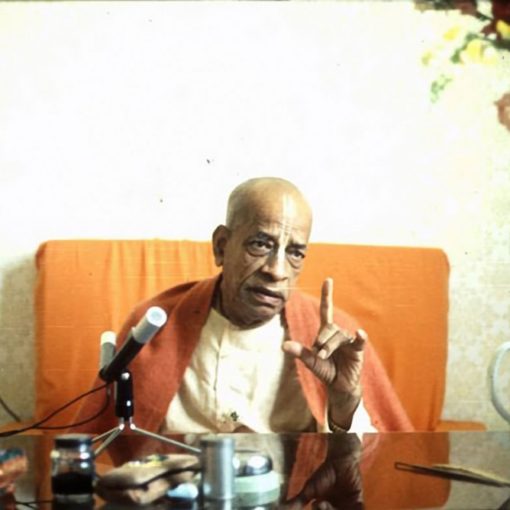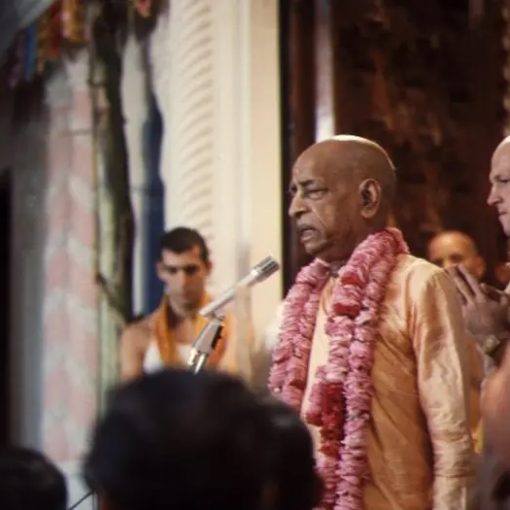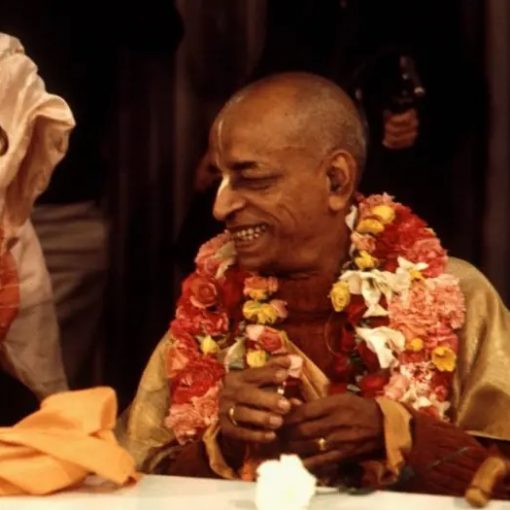Ramesvara Swami and Radhaballabha delivered the latest volume of Srimad-Bhagavatam, the second part of the Seventh Canto, to Srila Prabhupada in mid-afternoon. Srila Prabhupada was beaming with pleasure. He carefully inspected it, looking through the many beautiful paintings that depict the killing of the demon Hiranyakasipu by Lord Nrisimhadeva. Prabhupada was laughing as he described the fight. “‘All right, let me see how your strength is coming. Now I shall kill you, come on. Let me see how your God is coming to save you.’ This is atheism, challenging. And when He appeared, Hiranyakasipu became a fly in front of… Eh? Where is such language? Even there are many Sanskrit scholars now, they cannot produce such language. That is not possible. And five thousand years before, Vyasadeva presented this unique language.” Ramesvara informed him that it was the twentieth volume of Srimad-Bhagavatam now in print. “Out of sixty. Still forty,” Prabhupada said. “Twenty already printed, and two or three ready for being printed.” “But this is the bulk of the cantos, Srila Prabhupada,” Hayagriva mused. Ramesvara reminded him that the Tenth Canto will be very long and Prabhupada gave the breakdown. “Tenth Canto will be like Caitanya-caritamrita, fifteen volumes, Tenth Canto. Generally six chapters a volume, eh? So there are ninety chapters. That means minimum fifteen volumes, and maybe more. We have presented Krishna book, just a summary study, not explained. But when it will be explained, with each and every sloka, purport, then it will be not less than fifteen volumes. Tenth Chapter is the face of the Lord. We have described the legs, hands, belly, that’s all, and Tenth Chapter is the face, smiling face. Therefore we should not jump over to the face all at once. It must go from the legs, gradually, and then face, then forehead, then hair. Eleventh, Twelfth, finished, the whole body of Krishna. Hmm. So thank you very much.” As he looked over the new volume, admiring the high quality of the presentation, Kirtanananda Swami arrived. He had flown in from Pittsburgh especially to view the premiere of a new film made by Yaduvara dasa about New Vrindaban, called Spiritual Frontier. He brought with him some homemade ice cream and a considerable quantity of delicious New Vrindaban sweets. Prabhupada greeted him warmly, asking about his health and how things were going in New Vrindaban. “The devotees are all anxious for you, to see,” Kirtanananda said. Prabhupada broke out in a grin, and looking at Kirtanananda Maharaja’s old friend he joked, “Yes. And Hayagriva Maharaja is being forced?” “You should cane me more, Srila Prabhupada,” Hayagriva joined in, appreciating the affectionate attention. “No,” Prabhupada laughed. “Krishna is very cunning. One may try to leave Him, but He is not going to leave you. Once come, ‘No sir, you cannot go out.’ Just like our Ajamila. He was devotee in the beginning, and later on, by bad association of prostitute, he fell, but Krishna took him at the end. Svalpam apy asya dharmasya trayate mahato bhayat. Krishna gave him chance to give him a son. He kept the son’s name Narayana. So on account of affection of the son, he was chanting, ‘Narayana, Narayana, Narayana.’ Just Krishna is so kind that ‘All right, this rascal is going out of My hand. All right, give him a child, Narayana. He will chant, “Narayana, Narayana, Narayana,” and that will be his credit.’ Ajnata-sukriti. Na janma-koai-sukritibhir api labhyate. Sukriti, pious activities, of many millions of birth is not equal to love of Godhead. ‘Purchase Krishna consciousness anywhere it is available.’ What is the price? Tatra laulyam ekalam mulyam: ‘Only greediness, hankering. That is the price.’ ‘Oh, that I have got.’ ‘No, no. Na janma-koai-sukritibhir api labhyate. You cannot obtain this price even after millions of births’ pious activities.'” As he took some fresh juice and a little prasadam he noticed that I laid out a new silver spoon. He asked about it casually and I told him it was a gift from a few of the devotees. He didn’t inquire further and I was relieved. I had forgotten his original solid silver one in Hawaii and when we arrived I had to ask the devotees to buy him a new one. Prabhupada asked Kirtanananda Maharaja if he had seen the new book, offering to give him one. Kirtanananda said they were getting better and better. “Yes,” Prabhupada happily agreed. “And our Ramesvara Maharaja is guiding them.” Most of the other sannyasis were there and Prabhupada was in an expansive mood, so he told Pushta Krishna Maharaja to open up his closet and had him give one of his personal kurtas to each sannyasi. Before going down into the temple room to see the film he also had time to give a short personal darsana to Jay Warner, a young lawyer who has been giving a great deal of help to the devotees here and charging only his own costs. Jay appreciates the movement and the devotees, although it was evident from his questions that a full grasp of our philosophy has not yet dawned in his consciousness. Srila Prabhupada was happy to offer his help and guidance. “I do have one question,” Jay asked. “How can one establish faith in the principle of reincarnation? How can one come to believe in it?” “That is very simple thing,” Prabhupada told him. “That is stated in the Bhagavad-gita. Now, you were a child. That’s a fact. Were you not a child?” “Yes.” “Where is that body?” “Where is the body of the child?” “Yes. You were a child. Where is that body?” “It has grown into a man.” “Grown, or it is changed?” Prabhupada said. “The same thing. But that child, that body, is no more existing. Is it not?” “Yes,” Jay agreed, “it is gone.” “The body may vanquish, but you are going through. That is incarnation. The child body is vanquished; it is no more existing. Either you say grow or I may say it has changed, that body is finished. Is it not?” Jay understood the point but he had still had some doubts. “The difficulty for me reaches the moment, retroactively, before the moment of birth, or past the moment of death. How can one come to have faith that there is life after one leaves his body?” “This is the proof,” offered Prabhupada. “A child may not understand that, after his childhood body, there is another body, boyhood body or youthful body. He may not understand. But that is the fact. If the child says, ‘There is no more body. This is the final body,’ that is not the fact. He is going to get another body which is boy’s body, young man’s body, old man’s body. Similarly, you may believe or not believe, you are going to get another body. The proof is that you have no more the child’s body; you have got a different body. The common sense reasoning.” Although what he had told Jay was simple, clear and logical, something was holding him back from accepting it. “That is true. But the difficulty for me is that although my spirit wants to believe in transmigration, the scientific upbringing that was inculcated in me from a child has a hard time…” Prabhupada perked. “What is that scientific?” “Through empirical evidence, through evidence…” “This is evidence,” he told Jay. “I ask you to show me your childhood body. Where it is? Can you show? That is finished. So if the childhood body finished, you get another body, boyhood body. Similarly, the conclusion should be that after this body?I am old man; it will be finished?then I’ll get another body.” “That makes sense.” “Very common sense,” Prabhupada told him. “But we are so dull-headed we cannot understand.” Then he gave him the example of a film strip as further evidence to make sure he understood. “There are hundreds of bodies in the film, and when they are played, it seems that it’s the same?one man is moving?but actually, in the film there are hundreds of bodies, but it is changing so swiftly it appears one.” Now Jay began to catch on. “A man’s eye cannot see it changing.” “Yes. By nature’s law it is changing every second in such swift way that we cannot understand.” “How does one give up the fear of dying?” “There is no death,” Srila Prabhupada told him positively. “You change body. Because the body is lost, you are no more, you do not possess the childhood body, youth-hood body, that does not mean you are dead. You are living; the body has changed. But because we do not know the science, we think, ‘The body is finished; therefore he’s dead.’ Therefore you have to learn Bhagavad-gita na jayate na mriyate va kadacit [“The soul never takes birth nor dies at any time.” Bg. 2.20]”
How does one give up the fear of dying?
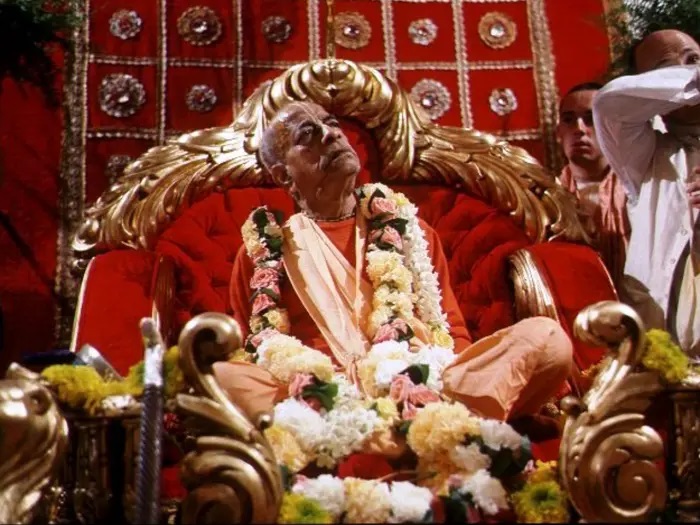

Reference: Transcendental Diary Volume 2 by Hari Sauri Dasa

